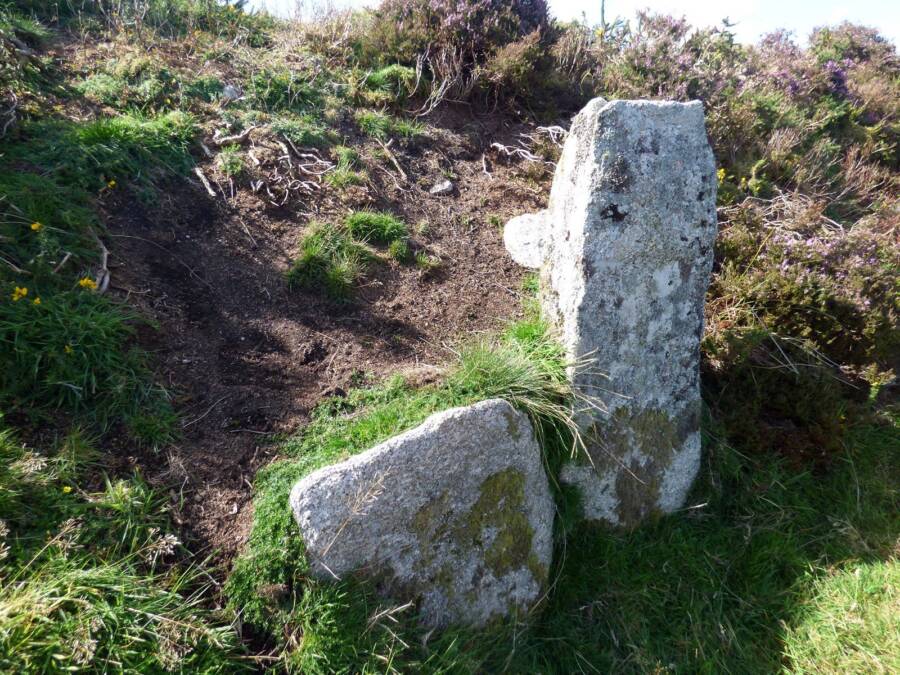A mysterious stone structure on Bodmin Moor in Cornwall, England that's long been associated with King Arthur was not built during the medieval era, but instead circa 3000 B.C.E.

Sandy Gerrard/Historic EnglandStone structures at King Arthur’s Hall in Cornwall, which were recently found to date back to the Neolithic era.
Researchers examining an historic site in Cornwall, England that’s linked to King Arthur have made a remarkable discovery. The stone and turf structure on Bodmin Moore known as “King Arthur’s Hall,” previously believed to be a medieval animal pen, has been revealed to be 4,000 years older than experts thought.
New findings have confirmed that King Arthur’s Hall dates back to prehistoric times and was likely built in approximately 3000 B.C.E. Experts are now calling the discovery a “major revelation” that could fundamentally change our understanding of prehistoric England.
Excavations At King Arthur’s Hall Reveal Its Prehistoric Heritage

Historic EnglandSome say King Arthur’s Hall served as a medieval cattle pen, but its true purpose remains mysterious to this day.
Despite its name, King Arthur’s Hall actually had virtually nothing to do with King Arthur — whose very existence is up for debate. Yet the historic site has been known by that name since at least 1583.
The site is a banked enclosure on Bodmin Moor, measuring about 160 feet long and 70 feet wide. It’s lined by 56 standing stones, each one up to six feet tall.
For centuries, the structures at King Arthur’s Hall were believed to be medieval, but local amateurs, in recent years, had begun to raise doubts about that. Following up on this, Cornwall National Landscape, which looks after the county’s protected land, commissioned an excavation involving various experts in partnership with Historic England.

Samantha Barnes-Knight/Historic EnglandKing Arthur’s Hall was likely built circa 3000 B.C.E., new research shows.
The excavation and subsequent soil dating, which used optically stimulated luminescence (OSL), revealed that the interior of the monument had been dug far earlier than expected — about 4,000 years earlier. Experts found that the site originally dated to sometime around 3000 B.C.E., meaning it was constructed during the Neolithic period.
“They’ve dug down through the earth of Bodmin Moor to the loose granite on the surface, and they piled it up to make these ramparts. And what they did in our favour was they buried these very ancient soils below them which we could target for OSL,” lead archaeologist James Gossip told The Guardian.

Mark Johnstone/Historic EnglandThe entrance to King Arthur’s Hall.
Speaking to the BBC, the University of St. Andrews’ Dr. Tim Kinnaird said the discovery was a “major revelation.”
“It’s extremely exciting that we’ve finally been able to date construction of this enigmatic monument, previously grounded in myths and legends,” he added.
The standing stones were the first major clue that the site was older than previously believed — though, of course, the location’s name also played into the misconceptions about its age.
King Arthur’s Hall Actually Predated The Legendary Figure By Thousands Of Years

Wikimedia CommonsA rendering of King Arthur receiving the fabled sword Excalibur.
It may seem strange to refer to this site as King Arthur’s Hall when it had nothing to do with King Arthur and isn’t even a hall. But historians do have an explanation for its unique name.
“The middle ages was a period when the Arthur name starts being attributed to all sorts of unusual sites that the local population at the time probably didn’t understand,” Gossip said. “That suggests its original function had been lost by that point, but people attributed it to King Arthur because he had this association with something mythical and powerful.”
The site had also been used and updated at various times throughout its history, but by learning just how far back that history goes, researchers can now begin to come to an understanding about its original purpose.
“Knowing when King Arthur’s Hall was built will help us understand this unique monument form better, how it might have originally been used and how it could have been used over time,” Gossip said.

Sandy Gerrard/Historic EnglandThe presence of standing stones at King Arthur’s Hall raised questions about when the site was first constructed.
Kinnaird added that archaeologists would “now have to re-appraise our understanding of the prehistoric landscape of Bodmin Moor.”
For now, more research needs to be done on the various samples taken from the site. But researchers are already beginning to form theories about what its original purpose may have been.
“The thinking is that these are meeting points for communities, perhaps to mark special occasions or to carry out ceremonies,” Gossip said.
“It remains as an enigma, but we now know a little bit more about it, and we can firmly place it in the prehistoric landscape context of Cornwall.”
After reading about King Arthur’s Hall, learn all about the legend of Excalibur, King Arthur’s famous sword. Then, read all about the legend of the Holy Grail.





